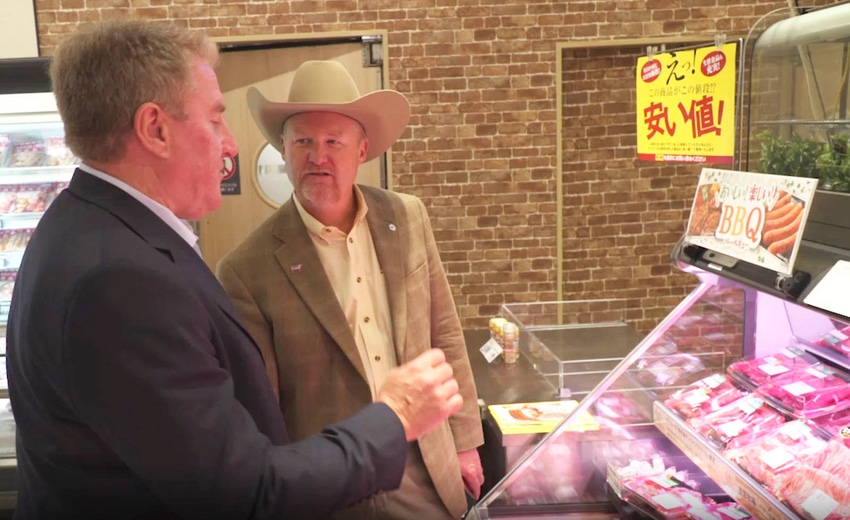USMEF Chair sees great benefits for U.S. beef in new agreement with Japan
Assuming the U.S.-Japan trade agreement is implemented soon, and reduced tariff rates are in place for the full year, USMEF projects U.S. beef exports to Japan to reach $2.3 billion in 2020 and to approach $2.8 billion by 2025.
November 7, 2019

"Visiting Sendai (Japan) was especially interesting because the city and surrounding region have an insatiable appetite for U.S. beef tongue. We had the opportunity to visit a tongue processing plant and see the product making its way into commercial channels. Having the ability to export tongues to Japan adds more than $12 per head to every fed steer and heifer slaughtered in the United States, so as a cattle feeder this was a great experience."
That’s just one of Cevin Jones’ reactions to his recent visit to Japan. Jones, a cattle feeder from Eden, Idaho, begins his one-year term as chair of the U.S. Meat Export Federation (USMEF) on Nov. 8. Jones has a long history of involvement with USMEF, dating back to his leadership roles with the Federation of State Beef Councils and the National Cattlemen's Beef Association.
Jones takes the helm at USMEF at an exciting time for the cattle industry, bolstered by the recent announcement of a new trade agreement with Japan. Though the agreement still requires approval by the Japanese Parliament, it is expected to take effect in early 2020.
Jones' most recent visit to Japan was with the USMEF Heartland Team – a delegation of 31 U.S. beef, pork, corn and soybean producers who spent a week in Tokyo and Sendai, meeting with importers, distributors and other buyers of U.S. beef and participating in USMEF promotional activities. He returned from Japan more enthusiastic than ever about the benefits delivered by the No. 1 destination for U.S. beef exports.
In addition to his experience in Sendai, Jones was also impressed with the wide range of U.S. beef cuts being merchandised and consumed in Japan, thanks in part to USMEF's efforts to introduce new menu options for restaurants and cooking techniques for consumers who enjoy U.S. beef at home.
"Grilling steaks is something that comes naturally in the U.S., but for many Japanese consumers it's not necessarily familiar to them," Jones explained. "The Heartland Team took part in grilling activities that gave us an opportunity to personally engage with consumers and show them the unique attributes of U.S. beef. Low-and-slow barbecuing methods are also gaining traction in Japan, which opens up some great new opportunities for U.S. beef."
U.S. beef exports to Japan reached $2.1 billion in 2018, accounting for about one-fourth of the worldwide record total of $8.3 billion.
"Last year that $8.3 billion equated to more than $320 per head of fed slaughter, so $80 per head can be attributed to Japan," Jones said. "Yet Japan's 38.5% tariff rate on U.S. beef cuts is the highest we face in any major market, so we know that beef exports to Japan still have not reached their full potential. That is what is really exciting about the U.S.-Japan trade agreement, which we hope to see ratified soon."
The agreement, which was first announced by President Trump in September and signed at the White House on Oct. 7, reduces tariffs on U.S. beef to the same rates as those currently being paid by Comprehensive and Progressive Agreement for Trans-Pacific Partnership (CPTPP) suppliers such as Australia, Canada and New Zealand.
Japan’s tariffs on U.S. beef cuts will be reduced from 38.5% to 9% over 15 years. Tariffs on beef tongues decline from 12.8% to zero by 2028, and the rate falls to zero for other offals by 2030. Tariffs on processed beef items are phased to zero in five to 15 years, depending on the product.
"The timing of the Heartland Team visit was ideal in that it allowed U.S. producers to see firsthand the excitement and anticipation this agreement has generated among our customers in Japan," Jones said.
"They see great opportunities to feature U.S. beef in a wider range of restaurants and retail venues once these tariff rates are reduced. So this agreement is not only great news for the U.S. industry, but also for Japanese consumers and our food industry partners in Japan."
Assuming the U.S.-Japan agreement is implemented soon, and reduced tariff rates are in place for the full year, USMEF projects U.S. beef exports to Japan to reach $2.3 billion in 2020 and to approach $2.8 billion by 2025.
"This agreement will not only allow the U.S. beef industry to better defend our existing business in Japan, but we'll also be competing in a larger market as tariffs decline and beef consumption expands," Jones explained. "We've seen that play out in South Korea, where tariff rates have dropped dramatically in recent years and U.S. beef exports to Korea have flourished. We're expecting to see similar results in Japan, but on an even larger scale."
Joe Schuele is vice president, communications, with the U.S. Meat Export Federation in Denver, Colo.
Source: USMEF, which is solely responsible for the information provided and is wholly owned by the source. Informa Business Media and all its subsidiaries are not responsible for any of the content contained in this information asset.
About the Author(s)
You May Also Like


.png?width=300&auto=webp&quality=80&disable=upscale)
